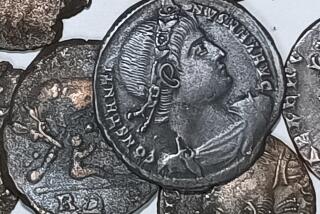Rosetta Stone’s City Seeks Its Sardines
- Share via
ROSETTA, Egypt — History made Rosetta one of Egypt’s best-known places, first as a major seaport for the Ottoman Empire, then as the city that gave its name to the Rosetta Stone, which yielded the key to ancient hieroglyphics.
But the Rosetta of today hardly does justice to its rich past. Few pay any attention to its history and the sardines that once gave it wealth vanished 20 years ago--victims of the Aswan High Dam about 750 miles south.
The town also languishes in worry about a destructive Mediterranean Sea, which took away its beach three years ago, swallowing up summer cabins and now threatening precious agricultural land.
Rosetta’s history lingers in 22 Ottoman-style, three-story houses tucked among new buildings. Long neglected, the houses overlook narrow streets shared by horse-drawn carts and 1956 Chevrolets.
“This collection of Islamic antiquities from the Ottoman Empire is second only to Cairo’s,” said Mohammed Mallah, curator of the Al Amasyali House, now restored and open as a museum of Rosettan life in the early 19th Century. “In fact, there are more old houses here than in Cairo.”
Founded in the 9th Century, Rosetta flourished and faded, then flourished again. By the 17th Century it had become one of the most important ports between Europe and Africa.
Gypsum figures in a recently restored military museum depict Rosettan townfolk pitched in hand-to-hand combat against Napoleon I’s troops in the late 18th Century and against British soldiers in 1807.
Napoleon’s soldiers found the Rosetta Stone in 1799. Twenty years later Jean-Francois Champollion, the world’s first Egyptologist, solved the puzzle of ancient heiroglyphic writing through texts from the Rosetta Stone, a basalt tablet now housed in the British Museum in London.
Rosetta’s importance began to diminish after that, and by 1819 it was no longer a major port because a new canal south of Rosetta diverted Nile trade to Alexandria, 40 miles to the west.
Rosetta, its treasures and its 80,000 people are on hardly any tourist’s itinerary these days.
Maybe it’s because it has no presentable hotels or restaurants. Or because of the disrepair into which most of the once-elegant houses have fallen, their intricately designed wooden ceilings and marble baths left dark and dusty.
The Egyptian government envisions a new future for Rosetta--tourism. A key to the plan is a new sea wall.
Local people hope the wall, however, in stopping sea erosion, will bring back the sardines.
“Rosetta was famous for its cafes. They were built and spread around with the sardine wealth,” said Helmy Zayed, head of the Rosetta City Council. “People caught sardines during the season, then spent their money on businesses, weddings, pilgrimage and coffee houses.
“We used to have heaps of sardines, so many you would lift them with spades. Every single person in our society has been affected by the lack of sardines, from the fisherman to the truck driver to the tradesman.”
But the building of the Aswan High Dam had blocked sea erosion-resisting silt far upstream in the Nile, and by the 1970s the Mediterranean was washing away 580 feet of Rosetta’s shoreline every year. The lack of silt, which contained nutrients that attracted the sardines, already had finished off the fishing industry.
An alarmed national government contracted with a company owned by the Nationalist Chinese government on Taiwan to build the $31-million seawall to protect the shoreline.
The wall is well along now, workers are restoring many of the old houses and mosques, and plans are in place for hotels and restaurants.
Officials say after completion of the seawall they will be able to build a summer resort and a modest hotel and restaurant.
“There’s a lot to see in Rosetta,” said Yehia Ibrahim Mohammed, a part-time museum employee. “We have some foreigners visiting now, but they’re mostly architects and Islamic art experts.”
More to Read
Sign up for Essential California
The most important California stories and recommendations in your inbox every morning.
You may occasionally receive promotional content from the Los Angeles Times.











